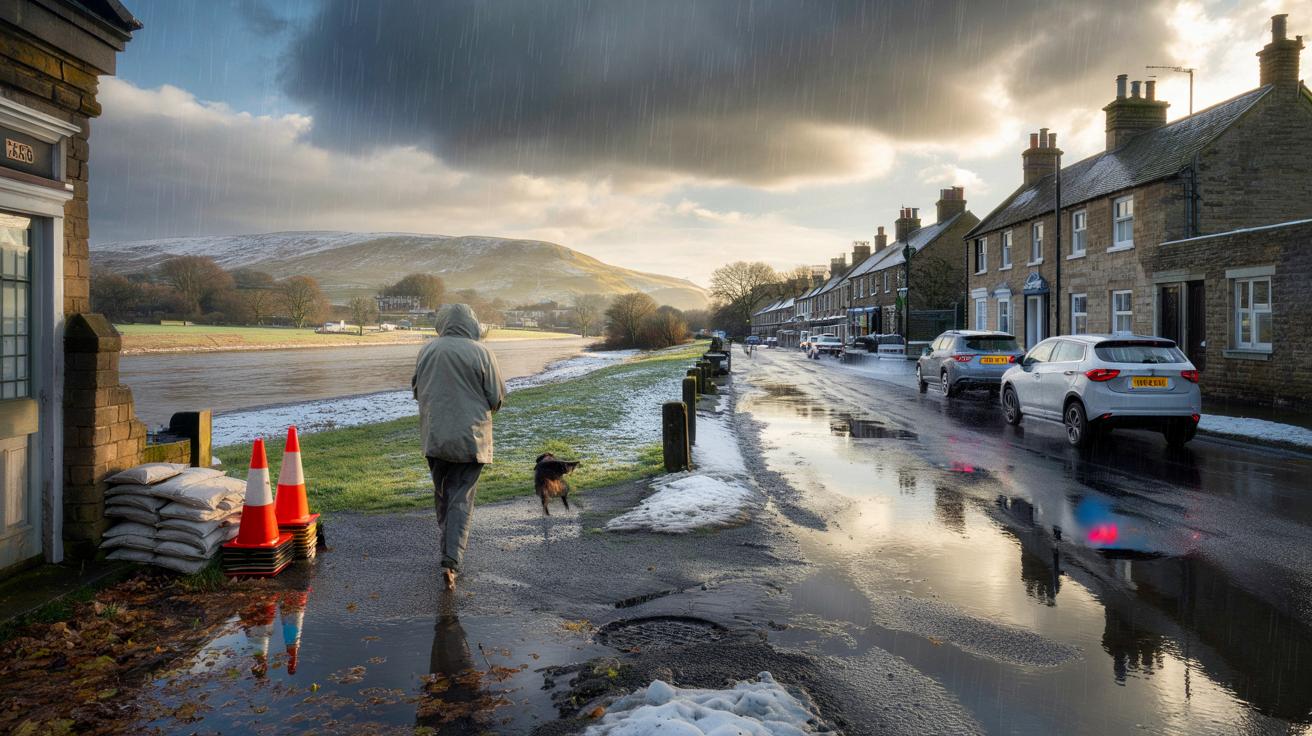Britain moves from frosty mornings to blustery showers as Atlantic systems edge in. Hill snow stays possible in Scotland, while many will notice brighter windows between fast‑moving bands of rain.
What happens next
Forecasters point to a cold northerly flow giving way to milder, moister air from the Atlantic. That change will not arrive at once. Showers and a stiff breeze keep a wintry feel at first, especially early on Monday. As fronts sweep southeast, cloud thickens, rain spreads, and temperatures creep back towards seasonal norms by midweek.
Single‑digit dawns give way to maritime air later this week, with daytime values broadly back in the 8–12C bracket for many.
Sunday delivered a bright but crisp start for central and eastern counties. Northern Ireland and Scotland turned cloudier with rain pushing in from the northwest. As that rain met colder air over the Highlands, a little snow developed over the highest routes, which is typical at this point in the season.
Where the snow goes
The window for snow sits mostly over Scottish mountains when pulses of rain brush colder air. Lower levels look too marginal for anything significant to settle. In England and Wales, the main hazard is wet and windy weather moving through quickly rather than snow, although exposed moors could catch sleety bursts for a time.
Snow risk is mainly confined to higher Scottish peaks when rain meets leftover cold air; most lowland areas face rain and brisk winds instead.
Wind and rain after storm Benjamin
The shift comes in the wake of Storm Benjamin, which brought widespread downpours and gusts topping 70mph during the week. Four yellow weather warnings covered parts of the UK on Thursday, and more than 40 flood alerts appeared as rivers responded. The strongest winds have eased, yet catchments remain sensitive. Any further bursts of heavy rain could raise the chance of surface water on roads and minor flooding in prone spots.
Gusts that topped 70mph midweek have eased, but saturated ground keeps surface water risks alive as new fronts arrive.
Day‑by‑day outlook
| Day | UK overview | North and Scotland | South and east |
|---|---|---|---|
| Monday | Chilly start, sunny spells and scattered showers. Cloud builds from the west, rain by evening. Breezy. | Showers at first, turning cloudy with rain pushing southeast. Hill snow possible for a time. | Bright spells early, staying mostly cloudy later. Patchy light rain may arrive late in the day. |
| Tuesday | Changeable. Bands of rain or showers at times. Drier breaks in between. | Frequent showers near western coasts. Brisk winds. Brighter intervals inland. | Often drier and brighter, with only isolated showers. Feeling a touch milder. |
| Wednesday | Unsettled west, more settled east. Temperatures nudging back towards average. | Further rain in the northwest. Cloudy and windy over high ground. | Longer sunny spells in the southeast. A few light showers possible. |
| Thursday | Similar theme: fronts near the northwest, drier windows elsewhere. | Rain or showers at times, especially on coasts and hills. | Often dry with bright periods. Light winds where skies clear. |
Regional snapshot
- Scotland: Rain spreads southeast with hill snow in the Highlands. Windy over coasts. Brighter gaps follow.
- Northern Ireland: Turning cloudy with rain at intervals. Showery mix midweek, feeling less cold.
- Northern England: Sunny spells and showers, then thicker cloud. Some persistent rain over the Pennines.
- Wales: Rain reaches higher ground by afternoon and evening. Showers linger in the west midweek.
- Midlands: Bright start in places, cloudier later with a few light and patchy showers.
- Southwest: Cloud and wind increase from the northwest. Rain brushes through, then clearer slots.
- London and the southeast: Often cloudy, limited showers. Brighter breaks at times and turning a touch milder.
The northwest bears the brunt of rain and wind; the southeast sees the best of the dry and bright spells.
Why the pattern is changing
The cold snap arrived as a northerly airflow pulled Arctic air straight across the UK. As the jet stream shifts and strengthens, Atlantic lows begin to win back territory. That brings cloud, frequent rain in the northwest, and a gradual recovery in temperatures. Air masses from the ocean hold more moisture and moderate the chill, which explains the jump from sharp frosts to grey but milder afternoons.
Travel and daily life
Morning commutes may start with icy patches where skies cleared overnight, especially on untreated surfaces in northern valleys. Wet roads then follow as rain arrives from the west. Rail operators often run de‑icing trains on key routes; short delays are possible where leaf‑fall and moisture reduce adhesion. Airports can see minor knock‑ons when visibility dips in showers, though widespread disruption looks unlikely.
- Leave extra braking distance in showery bursts and on wet leaves.
- Check local river levels if you live near flood‑prone stretches.
- Ventilate rooms briefly to reduce condensation as temperatures lift.
- Secure loose garden items ahead of blustery periods.
What the forecast means for you
Cold‑sensitive groups, including older people and those with respiratory conditions, may still feel the bite at dawn. Keep living areas warm early in the morning, then take advantage of milder afternoons to air out damp rooms. Dog walkers and runners will get decent windows between showers, particularly towards the southeast, but waterproof layers remain handy.
Flood risk after saturated ground
Where catchments received repeated downpours during Storm Benjamin, further rain can trigger quick responses. Low‑lying lanes near rivers and estuaries face the greatest risk. Keep an eye on official updates if you live near known hotspots, and report blocked drains to local councils to help reduce surface water build‑up.
Useful context
Yellow weather warnings flag a risk of disruption and ask the public to stay aware of changing conditions. They often focus on rainfall totals, wind gusts and the time of day when impact is likeliest. A yellow warning does not guarantee disruption in every location; it highlights areas where showers or bands of rain could hit hardest.
Snow on Scottish mountains during a cold‑to‑mild transition is a classic set‑up. Rain meets cold air over high terrain and briefly turns to snow or sleet, while valleys see cold rain. As Atlantic air settles, the freezing level lifts, and those wintry showers retreat to the highest summits. For drivers on routes like the A9, that shift often means wet roads rather than snow‑covered carriageways by midweek.









8–12C? I’ll take it.
Do those 40 flood alerts really fade, or are we just in a lull between fast‑moving bands? Our village by the Ouse saw drains back up after Benjamin, and the ground is still saturated. Should drivers expect more surface water hazards during the Monday PM rush if that next front arrives? Any guidence on peak timing for the northwest vs southeast would help.